SWVMC's Edo Maccari Administration Building
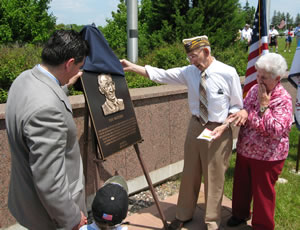
On May 28, 2006, during a Memorial Day ceremony at the Southern Wisconsin Veterans Memorial Cemetery (SWVMC), a new administration building was named in honor of Edo Maccari of Kenosha. The 92-year-old World War II veteran dreamed of a cemetery and a home for veterans in southeastern Wisconsin, and in the 1990s he approached WDVA with the idea. The Wisconsin Veterans Home at Union Grove and the SWVMC are located on the grounds of the Southern Wisconsin Center. Unveiling the building plaque are WDVA Secretary Scocos and his son Andreas (at left) and Edo Maccari with his wife Mary (at right).
AMVETS Memorial Carillon


The AMVETS Memorial Carillon was dedicated on May 31, 1998. The Carillon serves as a living memorial to America’s veterans who served their country honorably for the cause of freedom. “…As these bells ring…honored dead rest…freedom lives…”
Battle Cross Monument

The Battle Cross itself is not an official military honor, it does play the part in the memorial ceremony as a visible reminder of the fallen soldier. The origins of the Battlefield Cross or Battle Cross dates back to the Civil War as people would move through the recent battlefield to mark the bodies which needed to be recovered. During World War II Soldiers and Marines often buried fallen comrades in shallow graves placing the rifle with bayonet fixed into the ground and helmet on top. During Operation Iraqi Freedom and Operation Enduring Freedom the numerous units began erecting Battle Crosses to commemorate their comrades. The helmet and identification tags signify the fallen soldier, their name never to be forgotten. The inverted rifle with bayonet signals a time of prayer. The combat boot’s, represent the final march of the soldier’s last battle.
The monument was donated by Battle Cross, Ltd., organized on October 17, 2011. Its single purpose was to raise funds to purchase a Battle Cross monument for the cemetery. Ceremony and dedication was officially held September 29, 2012, nearly 16 years after the opening of Southern Wisconsin Veterans Memorial Cemetery to first-time burials.
Memorial Organizational Stones
The Southern Wisconsin Veterans Memorial Cemetery has dedicated five Memorial Organizational Stones to help honor, celebrate and remember the many sacrifices made by veterans. Memorial Organizational Stones serve to preserve awareness and provide recognition of historical events and groups at SWVMC.
United States Marines, Badger Detachment Marine Corps League, Devil Dogs Pound 14 – Stone Dedicated on October 6, 2000
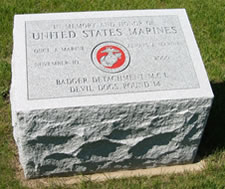
The Military Order of the “Devil Dogs” was organized and created in 1939 and granted a charter as a subsidiary organization of the Marine Corps League. The name Devil Dogs came into use during the fierce fighting between the Germans and the fifth and Sixth Marine Regiments in World I, the Germans began to refer to those Marines as “Teufelhunde” or “Devil Dogs.”
China-Burma-India Veterans Association Milwaukee Basha #1 – Stone Dedicated September 14, 2002
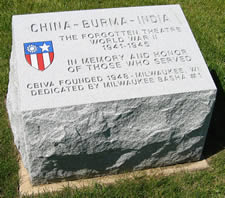
While it is well known that American troops advanced across the theaters of the European continent and the Pacific Ocean, they were also fighting and dying in remote locations. The Far Eastern theater, 12,000 miles from the United States and last on the list for supplies, reinforcements or mail, was called the "forgotten theater." For Americans most of the fighting in the theater took place on land that offered uniquely favorable conditions for unconventional warfare, in rugged mountains, narrow river valleys, monsoons and dense tropical vegetation. But those who served never forgot. After the war, a group of Milwaukee China, Burma, India vets started a local social club. The Milwaukee Basha, named after the bamboo and thatch huts where CBI vets lived overseas, became the China-Burma-India Veterans Association in 1948.
U.S. Navy Armed Guard, Illinois-Wisconsin Chapter – Stone Dedicated November 11, 2002
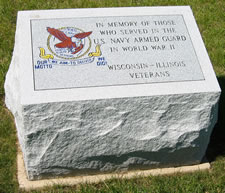 The Armed Guard was created as a branch of the United States Navy during World War I to protect the merchant ships of the United States by maintaining weapons on 384 merchant ships. During World War II, the Armed Guard was reactivated and expanded as a response to German strategy of attacking and sinking merchant ships. Nearly 2000 men lost their lives in defense of their country in this operation in WWII. Their sacrifice ensured that the supplies and materials needed to win the war arrived where they were most needed.
The Armed Guard was created as a branch of the United States Navy during World War I to protect the merchant ships of the United States by maintaining weapons on 384 merchant ships. During World War II, the Armed Guard was reactivated and expanded as a response to German strategy of attacking and sinking merchant ships. Nearly 2000 men lost their lives in defense of their country in this operation in WWII. Their sacrifice ensured that the supplies and materials needed to win the war arrived where they were most needed.
The Chosin Few – Stone Dedicated September 1, 2006
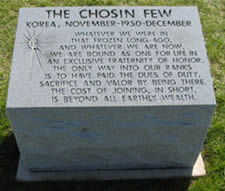
On September 1, 2006, the Wisconsin Chapter of the Chosin Few donated and dedicated an organizational memorial stone at the Southern Wisconsin Veterans Memorial Cemetery, Union Grove. The memorial was placed in honor of those who fought, died or survived the Battle of the Chosin Reservoir which took place in the icy, cold mountains of North Korea in November to December of 1950. The cemetery has an area next to the branch of service flag plaza between the columbarium and the casket burial gardens where organizations can place memorial stones.
U.S. Submarine Veterans WWII, Wisconsin Chapters – Stone Dedicated August 3, 2010

On August 3, 2010, the Southeast Wisconsin Chapter, United States Submarine Veterans of World War II donated and dedicated the 5th organizational memorial stone to the Southern Wisconsin Veterans Memorial Cemetery, Union Grove. The memorial was placed to perpetuate the memory of those shipmates who gave their lives in submarine warfare. The insignia of the U.S. submarine service is a submarine flanked by two dolphins. Dolphins, attendant’s to the Poseidon Greek god of the sea and patron deity to sailors is sometimes referred to as the sailor’s friend. They were also chosen to represent the Submarine Service because of the characteristic way in which they drive and surface. Most importantly the Dolphin Medal denotes “Qualified in Submarines“ for submarine sailors who passed their exams while on patrol.